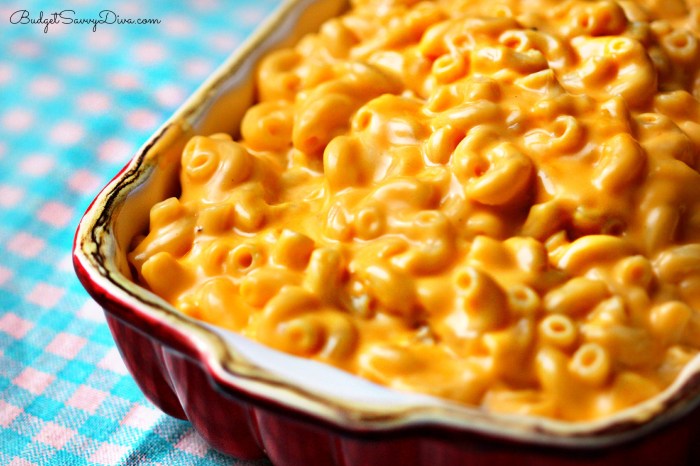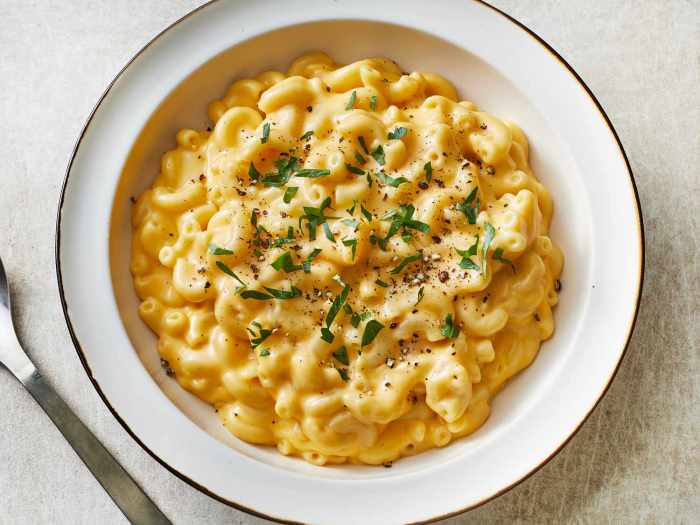Baked Macaroni Cheese Sauce Recipe
Baked Macaroni Cheese Sauce: A Culinary Journey: Baked Macaroni Cheese Sauce Recipe

Source: budgetsavvydiva.com
Baked macaroni cheese sauce recipe – Baked macaroni cheese, a dish beloved worldwide, boasts a rich history and diverse interpretations. Its origins are debated, with some tracing it back to early forms of macaroni and cheese in 18th-century England, while others point to similar dishes in various cultures. Over time, the dish evolved, incorporating different cheeses, pasta shapes, and flavor profiles, resulting in the regional variations we enjoy today.
This exploration delves into the art of crafting the perfect baked macaroni cheese, from cheese selection to baking techniques.
Introduction to Baked Macaroni Cheese Sauce
Baked macaroni cheese is a comforting classic, evolving from simple combinations of pasta and cheese into a globally-recognized dish. Regional variations showcase diverse culinary traditions. For example, a Southern US version might feature sharp cheddar and a buttery, breadcrumb topping, while a French version could incorporate Gruyère and a creamy béchamel sauce. Key ingredients include pasta (typically elbow macaroni or shells), cheese (a blend is common), a creamy sauce base (often a béchamel), and seasonings to enhance the overall flavor.
Cheese Selection and Preparation
The choice of cheese significantly impacts the flavor and texture of baked macaroni cheese. Cheddar, with its sharp, tangy notes and excellent melting properties, is a popular choice. Gruyère, a Swiss cheese, adds a nutty, complex flavor and a smooth, creamy texture. Fontina, an Italian cheese, offers a mild, slightly sweet taste and melts beautifully. The melting properties of each cheese vary; cheddar tends to become slightly stringy when melted, while Gruyère and Fontina create a smoother, more cohesive sauce.
For optimal texture, grating cheeses finely ensures even melting and prevents pockets of unmelted cheese.
Béchamel Sauce Techniques, Baked macaroni cheese sauce recipe

Source: allrecipes.com
A classic béchamel sauce forms the creamy base for most baked macaroni cheese recipes. It’s made by creating a roux (a mixture of butter and flour) and gradually whisking in warm milk until smooth and thickened. Alternative methods for a creamy base include using a cheese sauce directly, or a combination of cream cheese and milk. The desired consistency is crucial; a too-thin sauce will result in a watery dish, while a too-thick sauce will be heavy and pasty.
The béchamel should be smooth, creamy, and coat the pasta evenly.
Pasta Selection and Cooking
Elbow macaroni and shells are the most common pasta shapes used in baked macaroni cheese, due to their ability to hold the creamy sauce. Cooking pasta to an “al dente” texture – firm to the bite – is vital. Overcooked pasta will become mushy and detract from the overall texture. Different pasta shapes influence the final dish’s texture and presentation.
Smaller shapes like elbow macaroni create a more homogenous mixture, while larger shapes like shells can provide a more interesting visual appeal.
Flavor Enhancement and Seasoning
Elevating the flavor of baked macaroni cheese involves thoughtful seasoning. Spices such as nutmeg and paprika add warmth and depth, while herbs like thyme or chives provide a fresh, herbaceous note. A touch of mustard powder or Worcestershire sauce can add savory complexity. For a balanced flavor profile, consider incorporating both savory and subtle sweet elements. For instance, a pinch of brown sugar can complement the sharpness of cheddar cheese.
Common seasonings include salt, black pepper, garlic powder, onion powder, and cayenne pepper for a hint of spice.
- Salt: Enhances the overall flavor.
- Black Pepper: Adds a subtle spiciness.
- Garlic Powder: Provides a savory, pungent aroma.
- Onion Powder: Contributes a mild onion flavor.
- Cayenne Pepper: Adds a touch of heat.
Baking and Serving Suggestions
Baking macaroni cheese requires careful attention to achieve a golden-brown crust and a perfectly melted interior. A preheated oven ensures even cooking. A crispy breadcrumb topping can be created by mixing breadcrumbs with melted butter, herbs, and seasonings before sprinkling it over the macaroni cheese before baking. Serving temperatures and side dishes should complement the richness of the dish.
A hot macaroni cheese pairs well with steamed vegetables, while a warm serving might be better suited to a salad.
| Serving Temperature | Side Dish Suggestion 1 | Side Dish Suggestion 2 | Side Dish Suggestion 3 |
|---|---|---|---|
| Hot | Steamed Green Beans | Garlic Bread | Simple Salad |
| Warm | Roasted Vegetables | Sautéed Spinach | Fruit Salad |
Recipe Variations and Adaptations
Baked macaroni cheese can be adapted to suit various dietary needs and preferences. Vegetarian versions can omit meat and incorporate additional vegetables like broccoli or mushrooms. Vegan options can substitute plant-based cheeses and milk alternatives. Gluten-free versions utilize gluten-free pasta. Adding different proteins like cooked chicken or bacon, or vegetables such as peas or corn, can create exciting variations.
Individual portions can be baked in ramekins for a more elegant presentation, or a larger casserole dish for a family-style meal.
Storage and Reheating
Proper storage is essential to maintain the quality of leftover macaroni cheese. Allow the dish to cool completely before covering it tightly with plastic wrap or storing it in an airtight container in the refrigerator. It can be stored for up to 3-4 days. Reheating can be done in the microwave, oven, or on the stovetop. The oven method generally yields the best results in terms of texture and flavor.
Freezing baked macaroni cheese is also possible; allow it to cool completely, then wrap tightly in freezer-safe material. Thaw it overnight in the refrigerator before reheating.
FAQ Resource
Can I use different types of pasta besides elbow macaroni?
A creamy baked macaroni cheese sauce recipe hinges on a perfectly balanced cheese blend. For a unique twist, consider incorporating some of the savory depth found in a richer sauce, perhaps inspired by the techniques used in the arthur and sons vodka sauce recipe , though obviously omitting the vodka. This could add a surprising dimension to your classic macaroni cheese, resulting in a truly memorable dish.
Absolutely! Shells, cavatappi, or even rotini work well. Choose a shape that will hold the sauce nicely.
How can I make the topping extra crispy?
Use panko breadcrumbs instead of regular breadcrumbs for a crispier topping. You can also toast the breadcrumbs lightly in butter before adding them to the dish.
How long can I store leftover macaroni and cheese?
Store leftovers in an airtight container in the refrigerator for up to 3 days. Reheat gently on the stovetop or in the oven.
Can I freeze baked macaroni and cheese?
Yes, you can freeze baked macaroni and cheese. Let it cool completely, then wrap it tightly in plastic wrap and aluminum foil before freezing for up to 2 months. Thaw overnight in the refrigerator and reheat gently.





















